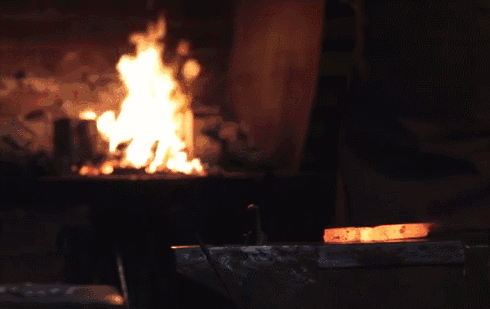HOW TO IDENTIFY REAL VS. FAKE DAMASCUS STEEL

Many people know about Damascus steel knives, and you must have heard about it, too. Although Damascus knife-making technology has been lost for hundreds of years, in recent years, various Damascus kitchen knives decorated with beautiful patterns have frequently appeared in the market, among which Damascus knives cast in Japan Steel knives are quite famous. So how is Damascus steel knife made? Why did it disappear while it was at its peak? And are the Japanese kitchen knives really the resurrection of Damascus steel knives? Let’s explore the story about Damascus steel knives.

HISTORICAL ORIGINS
There is a rumor circulating that Damascus steel swords are called the king of knives. They originated from the ancient city of Damascus in the Middle East, which is now the capital of Syria. However, in fact, the name Damascus steel swords is quite controversial. Ancient writers mentioned Damascus swords in their articles. At that time, the root word “Damas” was used, which means water in Arabic, which means that the surface of the knife has a pattern like water waves. Contrary to what most people think, Damascus steel is not a symbol of the advanced steelmaking technology of ancient times. It exactly reflects the backwardness of the ironmaking technology at that time and is a product of defects. Because there were high-quality magnetite in southern India at that time, the locals had mastered the iron-making technology very early. They mixed charcoal and iron ore, sealed them in clay crucibles, and heated them for a long time to produce iron. This iron ingot was exported to the Middle East. Called Utz iron, it is mixed with a variety of impurities, and iron with different carbon contents are interlaced to form patterns.
Manufacturing process
In order to restore the Damascus steel process, modern forging enthusiasts mostly use the pattern layer welding method. First, steel sheets with different carbon contents are staggered and welded, and then heated to high temperatures and repeatedly folded and forged. In this way, the number of layers becomes more and more, and each layer of steel becomes It becomes thinner and thinner, and after twisting and forging dozens of layers of steel bars bonded together, the steels of different textures will interlock, allowing the mixture of high carbon steel and low carbon steel to form steel and soft iron of different qualities. , hammered and welded to make the edge hard while taking into account the overall flexibility. After the steel is made into a knife, it is soaked in “acid” and etched. The hardest elements in the steel appear white or silver due to corrosion resistance. The soft elements in steel usually turn black or dark gray because they are susceptible to corrosion, eventually forming a pattern of black and white, with contrasting light and dark patterns on the steel body.

Identification method
1.”Perception”
Carefully observe the color of the blade texture to see if there is any bright color. After repeated forging, the density of high carbon steel and low carbon steel will increase, and it is not easy to rust and corrosion resistant. Since high carbon steel is corrosion resistant, it will appear after acid etching. The pattern has a unique bright color. Since the counterfeit Damascus steel has the same blade material, even if it has uneven texture and patterns, as long as the color is consistent, it is basically a counterfeit.
Check whether the pattern is blurry. The pattern of real Damascus steel is delicate, clear and natural, alternating between light and dark, and bright and gorgeous. On the contrary, if the pattern is dull and unclear, it is a fake.
Carefully observe the color of the blade texture to see if there is any bright color. After repeated forging, the density of high carbon steel and low carbon steel will increase, and it is not easy to rust and corrosion resistant. Since high carbon steel is corrosion resistant, it will appear after acid etching. The pattern has a unique bright color. Since the counterfeit Damascus steel has the same blade material, even if it has uneven texture and patterns, as long as the color is consistent, it is basically a counterfeit.
Check whether the texture is continuous, because the texture is formed by folding, twisting and forging a whole piece of Damascus steel. The texture is natural, smooth, continuous and irregular. The pattern of each Damascus steel is different, and the texture of the imitation Damascus steel is different. Is it intermittent or consistent in texture.
2.”Touch”
Real Damascus steel swords are swords made of Utz steel or composite steel. Since the blade contains two or more minerals of different materials, it will naturally form different colors after pickling. After cleaning and grinding, there will be a slight uneven feeling to the touch. If it feels smooth and has no slight unevenness, it is laser engraved. Of course, corrosion imitation and engraving imitation can also cause a concave and convex feeling, but this touch is uniformly rough, unlike real Damascus steel which is delicate.
3.”verify”
The pattern of real Damascus steel is not only on the surface of the knife body, but also has patterns on the cross section even after it is cut. However, if it is imitated by acid etching, engraving, or laser burning, there will be no pattern on the inside after cutting. Use sandpaper to polish the surface of the knife body. The fake Damascus steel imitated by single-layer steel has only an acid-etched laser-engraved pattern on the surface. It disappears after polishing. Even if it is pickled again, the pattern will not appear. However, the pattern of real Damascus steel. It is formed by forging, originating from the inside and exposed on the outside. No matter how the knife is sharpened, it will still reappear after pickling, and the pattern will always be there.
